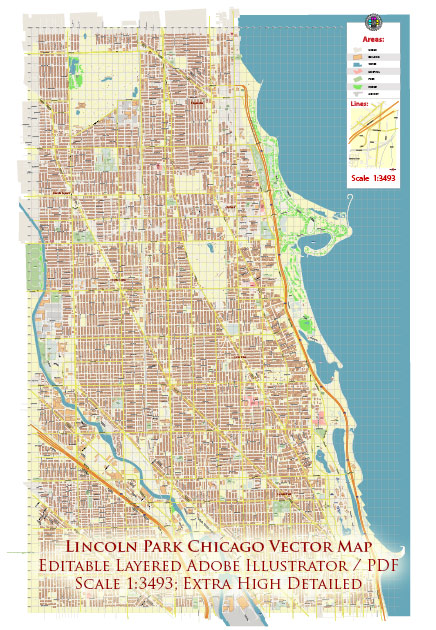Lincoln Park is one of the most iconic and historic neighborhoods in Chicago, Illinois, with a rich history of urban development that reflects the city’s growth and transformation over the years. The neighborhood is located just north of downtown Chicago and is bordered by Lake Michigan to the east.
Early History: The area that is now Lincoln Park was initially a cemetery called City Cemetery, established in the mid-19th century. However, due to various issues, including inadequate sanitation and the rapid growth of the city’s population, there was a need for a new cemetery. In the 1860s, the cemetery was transformed into a park, named after President Abraham Lincoln, who was assassinated in 1865.
Park Development: Lincoln Park underwent significant development in the late 19th and early 20th centuries. The park itself became a recreational hub with amenities such as walking paths, gardens, and a zoo. The Lincoln Park Zoo, established in 1868, is one of the oldest zoos in the country.
Residential Growth: As Chicago continued to expand, Lincoln Park transitioned from being primarily a park to a residential neighborhood. The late 19th and early 20th centuries saw the construction of elegant Victorian and Queen Anne-style homes, contributing to the neighborhood’s architectural charm. Many of these historic buildings have been preserved, giving Lincoln Park a distinctive character.
Cultural and Educational Institutions: Lincoln Park is home to several cultural and educational institutions. DePaul University, founded in 1898, has a significant presence in the neighborhood. The Steppenwolf Theatre Company, established in 1974, is a renowned theater ensemble located in Lincoln Park, contributing to the neighborhood’s cultural vibrancy.
Demographic Changes: Over the years, Lincoln Park has experienced demographic shifts, with waves of new residents and changes in economic status. The neighborhood has become known for its mix of young professionals, families, and students due to its proximity to educational institutions and employment centers.
Commercial Development: Lincoln Park features a vibrant commercial scene, particularly along Armitage Avenue, Halsted Street, and other major thoroughfares. The retail and dining options range from upscale boutiques to trendy restaurants, reflecting the diverse interests and tastes of the community.
Urban Renewal and Preservation: In recent decades, there have been efforts to balance urban development with the preservation of historic elements. The Lincoln Park Historic District, designated in 1972, helps protect the architectural heritage of the neighborhood. Community activism and engagement have played a crucial role in shaping development policies and ensuring the preservation of the area’s unique character.
Overall, Lincoln Park’s history reflects the dynamic evolution of urban spaces, from a cemetery to a recreational area, and finally to a thriving residential and commercial neighborhood that continues to attract residents and visitors alike.


 Author: Kirill Shrayber, Ph.D.
Author: Kirill Shrayber, Ph.D.